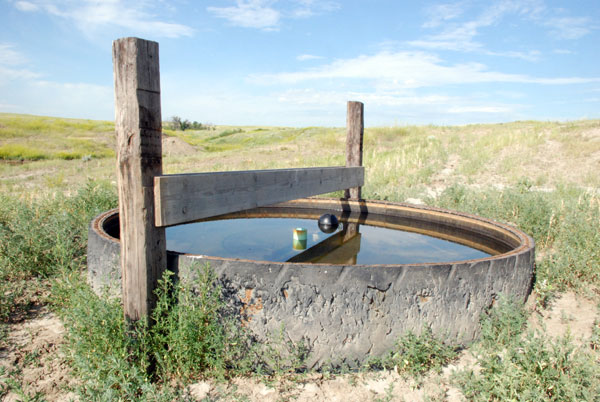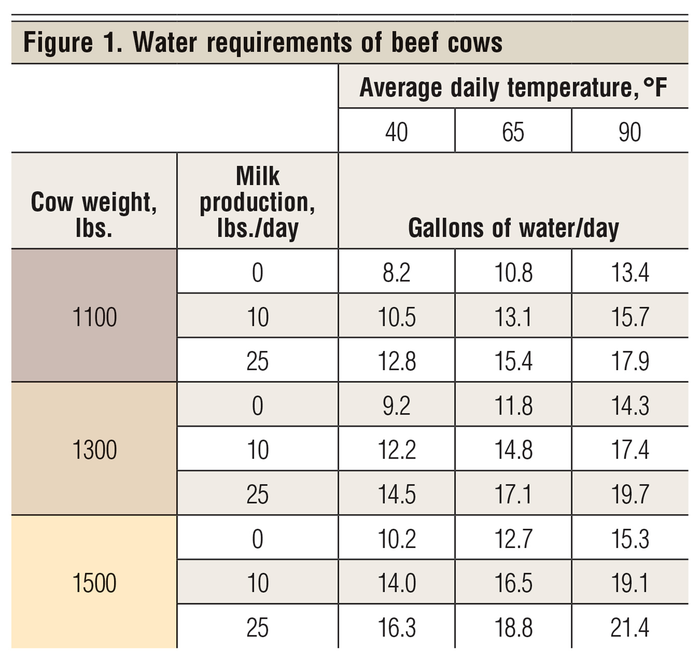How much water do cows need? The answer might surprise you.
May 11, 2018

By Justin Waggoner
A long-time rancher once observed that cattle drink twice as much water as usual when you have to haul it to them. While it may certainly seem that way, the truth behind that whimsical observation is that hauling water to cattle gives you a pretty clear idea of just how much they need to drink, especially on those hot summer says.
And the reality is, cows need plenty of water to get them and their calves through the summer heat.
Most cattle producers fully understand the importance of water. After all, providing an adequate supply of clean, fresh, water is the cornerstone of animal husbandry.
There are very few things that compare to the feeling of finding thirsty cows grouped around a dry tank on hot day. Water is important, and in situations where the water supply is limited or we are forced to haul water, one of the first questions we find ourselves asking is “how much water do those cows need?”
The old rule of thumb is that cattle should consume 1 to 2 gallons of water per 100 pounds of body weight. Accurately determining the amount of water cows will voluntarily consume is difficult and is influenced by several factors—ambient temperature, moisture and salt content of the diet, body weight, lactation, etc.
Water consumption increases linearly as ambient temperature increases above 40° F such that cows require an additional gallon of water for every 10 degree increase in temperature. Additionally, lactation also directly increases the amount of water required by beef cows.

Another question that often comes up related to water is: “How much water will my tank hold?” The capacity of a circular stock tank may be calculated using the equation below.
Circular tank capacity, gallons =
[3.14 x radius2 (inches) x depth (inches)]/231
Using this formula, a 12-foot stock tank with 24-inch sides would hold 1,691 gallons of water, which is enough water for approximately 85, 1,300-pound lactating beef cows producing 25 pounds of milk per day on 90°F day.
The third question that often follows is how much tank access is required for a given number of cows. A minimum of 15 inches of linear trough space per head is recommended and at least 10% of the animals in the pasture should be able to drink from the tank at once if the distance to the tank is relatively close.
In a larger pasture, where cattle are traveling longer distances to water, providing linear trough space for 30% of the animals in the pasture is suggested to allow more animals to access the tank at once and avoid over-crowding. The circumference of a round stock tank may be calculated using the equation below.
Circular tank circumference inches = 3.14 x diameter (inches)
A 12-foot diameter round stock tank (144 inches) provides 452 linear inches of drinking space, and would provide drinking space for a maximum of 30 head (15 inches per head).
As we can see by working through these calculations, the amount of linear drinking space provided by a tank, rather than capacity or volume of the tank, often determines the number of tanks required for a pasture or grazing site.
Water is important. The daily water requirements of beef cows in this article are estimates and water consumption varies greatly during the summer months when the temperatures exceed 90° F. Therefore, these recommendations are minimum guidelines. There are a number of excellent resources available on the web regarding livestock water requirements and water site development.
Justin Waggoner is beef systems specialist in Garden City for Kansas State University Extension.
You May Also Like



